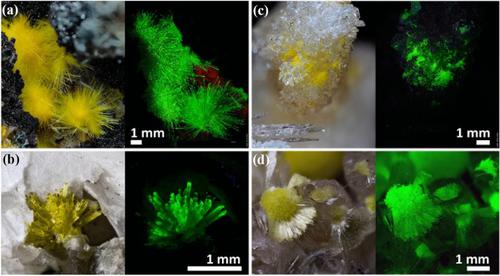Physics and Chemistry of Minerals ( IF 1.4 ) Pub Date : 2022-12-02 , DOI: 10.1007/s00269-022-01225-2 Martin Stark , Markus Noller

|
The luminescence of the uranyl cation UO22+ depends on the local crystalline environment and is sensitive to structural influences. Steady-state photoluminescence emission spectra of the related uranyl silicates uranophane-α, uranophane-β, sklodowskite and haiweeite from various locations are presented and discussed in the light of structure–property relation. The four mineral species were chosen for their close relationships: uranophane-α and uranophane-β are polymorphs and share the underlaying topology with sklodowskite. Haiweeite, with different topology, shares the composing elements Ca, U, Si, O with uranophane, while in sklodowskite Mg replaces Ca. All species show some variability in their spectra, parameterized as a variation of the centroid wavelength. Those variations are linked to defects and structural disorder, relevant in studies of uranyl speciation and migration. We present empiric spectra of the four mineral species with the least influence of structural disorder. As an unexpected feature, a prominent—partly dominating—double peak structure occurs in the case of uranophane-α only, while it is absent in the spectra of the other species. Considering a model of luminescent transitions in the uranyl ion in more detail, this observation is discussed in the light of the polymorphism of uranophane. We show evidence that variable amounts of uranophane-β phase embedded in uranophane-α are possibly at the origin of this spectral signature. Growth of those uranophane-β clusters might be induced by defects in the uranophane-α lattice and further promoted by the polymorphism of uranophane.
中文翻译:

铀酰硅酸盐 uranophane-α 和 uranophane-β 的光谱变异性:多态性和发光
铀酰阳离子 UO 2 2+的发光取决于当地的结晶环境并且对结构影响敏感。根据结构-性质关系,呈现并讨论了来自不同位置的相关硅酸铀铀矿 uranophane-α、uranophane-β、斜钛矿和 haiweeite 的稳态光致发光发射光谱。选择这四种矿物是因为它们的密切关系:uranophane-α 和 uranophane-β 是多晶型物,并且与 sklodowskite 共享底层拓扑结构。具有不同拓扑结构的Haiweeite与铀矿共享Ca,U,Si,O的组成元素,而在sklodowskite中Mg代替Ca。所有物种的光谱都显示出一些可变性,参数化为质心波长的变化。这些变异与缺陷和结构紊乱有关,与铀酰形态和迁移的研究有关。我们展示了结构紊乱影响最小的四种矿物的经验光谱。作为一个意想不到的特征,突出的 - 部分主导的 - 双峰结构仅出现在铀矿-α 的情况下,而在其他物种的光谱中不存在。更详细地考虑铀酰离子中的发光跃迁模型,根据铀矿的多态性讨论了这一观察结果。我们证明有证据表明嵌入铀矿-α 中的不同数量的铀矿-β 相可能是该光谱特征的起源。这些铀矿-β 簇的生长可能是由铀矿-α 晶格中的缺陷引起的,并由铀矿的多态性进一步促进。突出的(部分主导的)双峰结构仅出现在铀矿-α 的情况下,而在其他物种的光谱中则不存在。更详细地考虑铀酰离子中的发光跃迁模型,根据铀矿的多态性讨论了这一观察结果。我们证明有证据表明嵌入铀矿-α 中的不同数量的铀矿-β 相可能是该光谱特征的起源。这些铀矿-β 簇的生长可能是由铀矿-α 晶格中的缺陷引起的,并由铀矿的多态性进一步促进。突出的(部分主导的)双峰结构仅出现在铀矿-α 的情况下,而在其他物种的光谱中则不存在。更详细地考虑铀酰离子中的发光跃迁模型,根据铀矿的多态性讨论了这一观察结果。我们证明有证据表明嵌入铀矿-α 中的不同数量的铀矿-β 相可能是该光谱特征的起源。这些铀矿-β 簇的生长可能是由铀矿-α 晶格中的缺陷引起的,并由铀矿的多态性进一步促进。将根据铀矿的多态性讨论这一观察结果。我们证明有证据表明嵌入铀矿-α 中的不同数量的铀矿-β 相可能是该光谱特征的起源。这些铀矿-β 簇的生长可能是由铀矿-α 晶格中的缺陷引起的,并由铀矿的多态性进一步促进。将根据铀矿的多态性讨论这一观察结果。我们证明有证据表明嵌入铀矿-α 中的不同数量的铀矿-β 相可能是该光谱特征的起源。这些铀矿-β 簇的生长可能是由铀矿-α 晶格中的缺陷引起的,并由铀矿的多态性进一步促进。



























 京公网安备 11010802027423号
京公网安备 11010802027423号